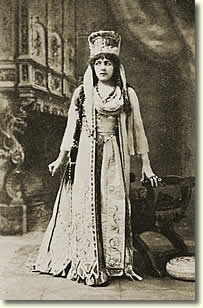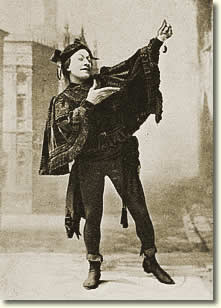 |
 |
||||||
NOTES ON THE TEXT
by Clifton Coles
The Beauty Stone was deliberately conceived as a musical drama different from every other production that had preceded it at the Savoy Theatre. As such, the authors courted disaster. It is indeed an intelligent, well-crafted play with complex characters developed through compelling situations and where the internal conflicts of the characters are as important as the external plot. Unfortunately, the Savoy was not the best place to produce such a drama. The Savoy audience wanted humor, and not to provide them with any was a great mistake. This and competition from the new theatrical art form of musical comedy produced at other London theatres sealed the opera's doom.
The genesis of The Beauty Stone lies with Joseph William Comyns Carr (1849-1916) and his (none too novel) idea that only through blindness can true love be realized. Carr, a competent dramatist and critic, wrote the text for Henry Irving's grand production of the King Arthur legend for which Sullivan had provided the incidental music score in 1895. Sullivan had in the past toyed with the idea of an opera on the same subject, and was pleased when Carr was able to offer him a similarly romantic work with a medieval setting.
Arthur Wing Pinero (1855-1934) was at the height of his career in 1898, having produced his most enduring success The Second Mrs. Tanqueray in 1893. One of the most important and popular of British playwrights, Pinero was later knighted for his services to dramatic authorship. His fifty-nine plays include The Notorious Mrs. Ebbsmith (1895), Trelawny of the "Wells" (1898), and The Gay Lord Quex (1899). In the output of his work, however, The Beauty Stone is all but forgotten.

Like in much of Pinero's drama, the emotional center of The Beauty Stone lies with the women: Saida, Laine, Jacqueline, and Joan. In making Saida a sort of villainess, Carr and Pinero gave her vibrancy and life that they denied Laine the heroine, who is obviously destined from the beginning to marry Philip and who is further made uninteresting by her pervasive Christianity. Sullivan proved where his interest lay by applying a lackluster leitmotif to Laine, the refrain of the 2/4 melody associated with her prayer early in the opera. The tune is especially dull when compared with the music written for Saida, especially her aria "Mine, mine at last!" in Act III, which is a truly uncharacteristic piece of dramatic vocal writing. Later, when Saida throws away the beauty stone she has spent much of the act trying to gain, she does so, in David Eden's phrase, "with a yell of real fury" that is equally uncharacteristic.
Sullivan considered his collaborators extremely uncooperative. He asked for changes in the musical construction, but they refused to alter what they had written, The only concession Sullivan seems to have won is the Recitative/Quartet in Act I, "Who stands within?" which originally was to have been performed as spoken dialogue. There are many other places in the libretto where spoken dialogue could have been turned into sung verse, and Sullivan probably desired as much, but having won this small victory, Sullivan did not press the issue.
The complexities of the verse, including the length of some individual lines, apparently stirred Sullivan to compose one of his best scores for the stage. It is unfortunate that the opera's surface characteristics, particularly the lengthy passages of pseudo-medieval dialogue, have contributed to this work remaining in virtual obscurity.
For all the score's accomplishment and the story's humanity, The Beauty Stone failed. Considering the evening too long, the authors began making revisions soon after opening night. They cut two numbers entirely and shortened the beauty pageant scene, as well as making huge excisions in the dialogue. Their work went for nothing, however; The Beauty Stone closed after fifty performances, one of the shortest runs of any Savoy opera and the least successful opera of Sullivan's mature career.
The only Savoy performer from the 1880s who appeared in The Beauty Stone was the indefatigable Rosina Brandram, the most loyal and dedicated Savoy artist and definitely one of Sullivan's favourites. Little is written about her, but her vocal ability and her skill as an actress are obvious in the music written for her and the parts she was called upon to play. The part of Joan is one of the few roles she played that was not of noble birth and the only one downright poor.

Ruth Vincent played Laine, winning the part through contractual obligations rather than on the recommendation of the composer, who wanted an outside artist to play the part. The Savoy's resident singer/dancer Emmie Owen created the part of Jacqueline. Covent Garden soprano Pauline Joran played Saida. Cunningham Bridgeman called her "unquestionably the finest prima donna ever seen on the Savoy stage," and the music Sullivan provided for her supports that assessment.
On the male side, Walter Passmore played the principal comic role of the Devil. The roles of Philip and Guntran went to two Americans, George Devoll and Edwin Isham, neither of whom had much experience on the stage but both possessed of fine voices. Lastly, that eternal Savoyard Henry Lytton played Simon, and was much praised for his impersonation both as an old man and as the young lover he is transformed into.
The vocal score and the second edition of the libretto are available in the microforms collection English Drama of the Nineteenth Century. A more detailed article, "Sullivan, Pinero, and The Beauty Stone" by George Rowell, can be found in the Sir Arthur Sullivan Society's magazine No. 21 (Autumn 1985).
Page modified 27 September 2011